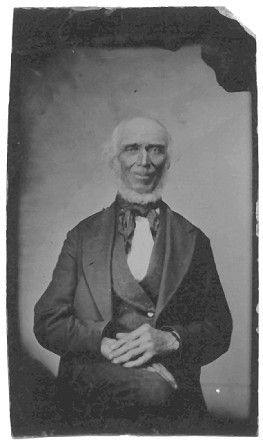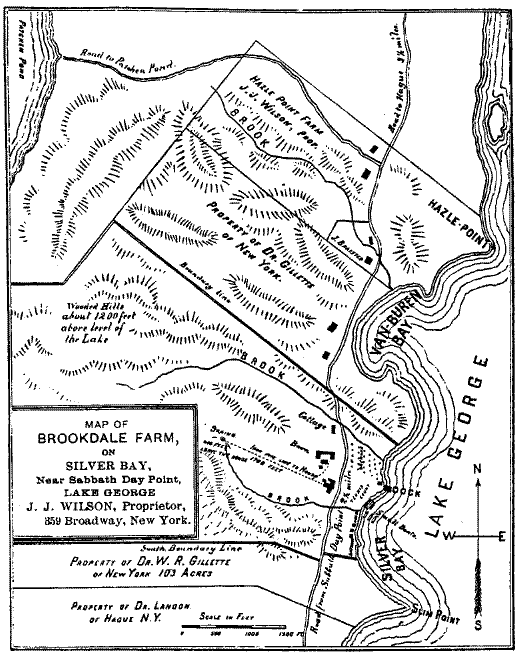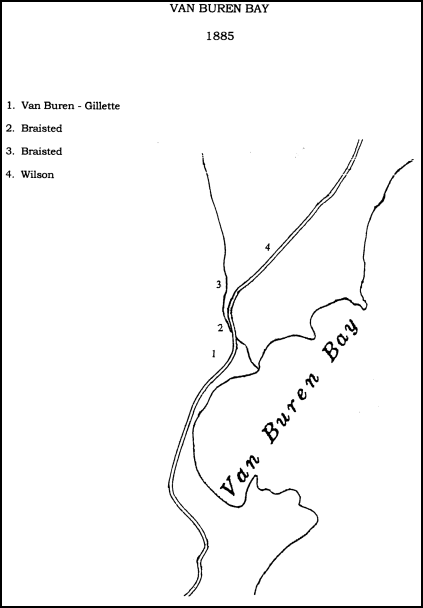

Benjamin Van Buren's Bay
Charles G. Gosselink
Contents Previous Next
 |
 Benjamin Van Buren's Bay Charles G. Gosselink Contents Previous Next |
Most of the present owners of property on what is now usually known as Oneida Bay who try to trace their deed history will eventually find that the land they own was once part of "that certain piece and parcel of land lying and being in the Town of Hague, County of Warren, State of New York . . . Lot 97 of the Ellis Patent, bounded in part or wholly by Lots 96, 109, and 98, supposed to contain 161 acres of land . . . being the same place known as the Benjamin Van Buren farm."[1]
 Hague Historical Museum | |
| Benjamin Van Buren 1800-1877 |
Benjamin Van Buren's farm, in other words, was all that land from the bend of the Silver Bay Road just below the Silver Bay General Store to Paine Hall and Tower Point, from the shore of the bay to the cliffs above Terrace Road. Surprisingly, Benjamin Van Buren never had title to that land, but he lived there for thirty years, perhaps paying rent or perhaps simply occupying the land, before his daughter Julia bought the property in 1875. There he had his log house[2] and farm and there he and his wife raised their family of eight children. A map of Warren County printed in 1858 as well as an atlas of the county published in 1876 show B. Van Buren occupying Lot 97.[3] There is some tradition that he lived up on the ledge, where Route 9N runs now, but the map shows his house right on the road from Sabbath Day Point to Hague, which we call the Silver Bay Road. We have no records or description but we can imagine his farm, with cleared land and growing crops, extending along the road beside the bay and on to the meadow below what is now Paine Hall. And the bay became known as Van Buren Bay.
According to the census records, Van Buren arrived in Hague in 1847.[4] He is listed as a farmer, so we may assume that he established his farm shortly after his arrival. He came with his wife Jane and two daughters. There are some discrepancies in the census records over the years, but the report in 1855 lists Van Buren as 55 years old, mulatto, born in Rensselaer County. The census of 1800 shows a Henry Van Buren living in Troy. He is described as "a free Negro" heading a household of five people.[5] As there were no other free Negroes of that name living in Rensselaer County, it seems likely that our Benjamin was Henry's son and was therefore himself born free. We have a picture of Benjamin Van Buren, taken perhaps in the 1870's. He is a distinguished looking black man, staring confidently at the camera, with a slight smile on his face. He is nearly bald but has a short, white beard. He is wearing a three-piece black suit with a black cravat. He has big hands and the long bony fingers of a lifetime of hard physical work.
Jane is listed as being 28 years old[6], mulatto, born in Warren County. In 1855, they already had five children. Lucinda, eleven, and Julia, nine, were born in Essex County, suggesting that the family had lived further north before making their way to Hague. The next two boys, Benjamin Jr, born in 1849 and Martin, in 1851, carry familiar names. Hiland, of whom we will hear more later, was born in 1853. Subsequent census records show that William arrived in 1856, followed by Charley in 1858 and Mary in 1861. The records are not entirely clear, but it would appear that some of the children married or moved away, for they are not all mentioned with the family in later census reports.[7]
Jane Van Buren died, at age 41, in 1866. She is buried in the old cemetery on Pine Orchard Road, just south of Hague, near Jabez Patchin's grave.[8] She has a large, well-made headstone, still upright, in the back corner of the lot. Benjamin died in 1877. He is listed as being buried in the Hague cemetery on Route 8, but neither his nor any other Van Buren grave has been found.
In 1871, Edward Ellis, an Englishman who had title to a great deal of land in Warren and Essex counties, sold his holdings, including Lot 97, to Charles Wheeler of Ticonderoga. In 1873, Wheeler sold Lot 97 of the Ellis Tract[9] to Samuel Westurn of Hague, the proprietor of a hotel at Sabbath Day Point, and he in turn, in 1875, sold it to Julia Van Buren of Hague for $253, retaining for himself all mining and mineral rights. The census of 1880 shows Julia living with her younger siblings, presumably on the family farm. Shortly thereafter, however, she married Charles Holcomb of Hague and they moved west to Amboy, Lee County, Illinois, perhaps taking the younger members of the family with them. Who was left on the farm? On October 10, 1885, Julia and Charles Holcomb, in Illinois, signed a deed turning over the property, for $1000, to Hiland Van Buren of Hague. On October 24, Hiland sold the property to Walter R. Gillette of New York City. Hiland must have been illiterate, for he signed the deed "X" his mark, but he sold the property for $1700, not a bad return on his two-week investment.
The New York census reports of 1892 and 1905 show Martin and Hiland continuing to live and work in Hague, as farmers. Martin's wife's name was Wealthy and they had two sons, Halsey and Henry, and a daughter, Krista. Halsey later married Edith Case and they had five children, but we have no further details. The 1892 census also names William Van Buren. He is listed as a laborer, 34 years old, in the household of J. J. Wilson, the proprietor of Brookdale Farm on Silver Bay, of whom we will hear more later. A survey of houses in Hague made in 1940 shows Hiland Van Buren's home on Battle Hill Road, though by that time it was owned or occupied by Jehira Fish.[10] After that we lose track of the family.
Clifton West, of Hague, remembered seeing Hiland, but only once when he was very young. He had never seen a black man before and was frightened. Dorothy Goodfellow, of Silver Bay, seems to have been better acquainted with the family. She recalled, as a child, walking home alone from school on Split Rock Road when "old Mr. Van Buren" stopped his buggy and gave her a lift. That must have been in about 1915. He was delivering plums to Rhoby Braisted.[11] Those two would have been old friends, having grown up together as next-door neighbors on Van Buren Bay. We hear no more of the Van Burens and a search of the census records fails to show the Holcombs in Indiana.
Dr. Walter Gillette was a practicing physician, who in later years became a vice-president of the Mutual Life Insurance Company of New York. He owned the farm property on Bluff Head, across the lake from Sabbath Day Point. He also had property at Sabbath Day Point and contributed to the construction of the Grace Memorial Chapel there.[12] At one time he owned 103 acres of land which included Slim Point, later purchased by the Silver Bay Association. In 1885 he bought the Van Buren property, and if the tax records are correct, he is the one who built, in 1890,[13] the Glen Cottage, now known as Birch Glen, owned by Chuck and Char Gosselink.
An early picture of our bay, taken in about 1900, shows one house, the Glen Cottage, close to the lake, dwarfed by the trees and the mountain hanging over it. But it was not the only house on the bay. Just to the north, around the corner of the Silver Bay Road were two houses belonging to the Braisted family. The Braisteds had moved to Hague in 1865. Their small triangle of land was bounded on the south by the Van Buren Farm and on the west, north, and east by the Hazle Point Farm, owned by J. J. Wilson. As noted earlier, Judge Wilson also owned Brookdale Farm on Silver Bay, the property that was to become the Silver Bay Association. Hazle Point Farm consisted of almost all of Lot 96 of the Ellis Patent and extended from the northern boundary of the Van Buren Farm to what is now the Post Office and from the highland above Watts Hill to the lake at Hazle Point, now usually known as Rowan Point.
But the Braisteds were there before Wilson and at one point they had owned all of that property. The Warren County atlas of 1876 shows their two houses on Lot 96. Most of their original property has passed on to other owners, but the Braisteds are still here. John and Betty, their son Jim and daughter Kathy Santaniello trace their ancestry back to those early pioneers of Silver Bay, and are our oldest Van Buren Bay family. We will follow their history later, but note here that property owners on the northern side of the bay who don't have Benjamin Van Buren in their history must trace their property history back to John and Rollin Braisted.
Dr. Walter Gillette held the Van Buren Farm, Lot 97, for only a short time, but he tried to leave his mark. There is a map of Brookdale Farm in Silver Bay House, a promotional brochure advertising J. J. Wilson's hotel on Silver Bay, published in 1889 and again in 1895.[14] The map includes the adjacent area to the north: Gillette's property, the Braisteds' homestead, and Wilson's Hazle Point Farm. The maps in the two versions of the brochure are practically identical, with one exception. The 1889 map shows Gillette's property on Van Buren Bay. The 1895 version calls it Gillette Bay.

From Silver Bay House, 1889
Walter Gillette passed out of our history in 1896, when he and his wife Annie C. Gillette sold the Van Buren Bay farm to Silas H. and Mary S. Paine for $12,500.[15] Silas Paine, of New York, was a wealthy executive of The Standard Oil Company. Sometime in about 1891 or 1892, on the recommendation of a friend, he and his wife spent a July vacation at Judge Wilson's Silver Bay House. They immediately fell in love with the area. One day, we are told, they walked out to what is now known as Tower Point. Looking at the lake from north to south as far as he could see and then up to Sunrise Mountain, Paine declared, "If I can, I will buy all of this."[16] For his part, Judge Wilson seems to have been amenable, for in 1892 he sold Silas and Mary Paine three and a half acres of land on the northern edge of his Silver Bay property, extending from the road to the lake, the land on which Paine Hall is built. Evidently Gillette, too, was willing, because in 1896 he sold the Paines the rest of Tower Point[17] and the entire Van Buren farm.[18] Shortly, of course, Paine also bought Silver Bay House and the surrounding land extending to Sunrise Mountain and Jabez Pond, constructed a new hotel, and eventually sold that property to the Silver Bay Association, but that is another story. The Paines also developed and began the transformation of the land they had purchased, changing Benjamin Van Buren's quiet wooded farm into something more like the busy Oneita Bay we know today.
 from Memories of Silver Bay | |
| Silver Bay Landing and Paine Hall 1912 |

[1] Warren County Registry of Deeds, Book 50, page 72.
[2] NYS Census Index for Hague, Warren County 1875.
[3] Crandall Public Library, Glens Falls, NY. Seneca Ray Stoddard's 1888 map of Lake George also shows Van Buren's house, but by that time the property had passed into different hands.
[4] NYS Census Index, for Hague, Warren County, 1855. The US Census of 1850 also lists the family but gives fewer details.
[5] Thanks to Marie Agnew-Marcelli for tracking down Henry Van Buren.
[6] The ages given are proximate and differ from census to census. She may have been 30 in 1855.
[7] The 1870 census report does not show Julia Van Buren but does list Cora Van Buren, 1 year old, granddaughter, living with the family. Hague historian Clifton West thought Julia A. Van Buren was the same person as Julia A. Robbins, wife of Solomon Robbins, and their ages are approximately the same. The Robbins family lived in Hague and had five children. But Solomon and Julia Robbins are buried in the Hague cemetery and Julia Van Buren probably died in Illinois. In 1880, the census records show that Julia was again living on the family farm with some of her siblings, as was Cora, now nine years old.
[8] Jabez Patchin, for whom the pond is named, was probably the first person to build and live on the Silver Bay Association property. He had his cabin where the south wing of the Inn stands now.
[9] In other deeds and maps, this is known as the Ellice Tract or Patent. In 1793, Alexander Ellice, an Englishman recently arrived from London, purchased 40,000 acres of land, between Sabbath Day Point and Chilson, from three men, Robert Cochrane, James Caldwell, and Robert McClallon. They had acquired the land from the Crown in 1769. (Charles C. King, Andia-ta-roc-te, 1935, p.37.) Many parcels of that land had already been sold off before Ellice's son, or some other inheritor, Edward Ellis (a variant spelling), living in London, sold what remained of it in 1871.
[10] Records in the Hague Historical Museum and the office of the Warren County Historian.
[11] Dorothy W. Goodfellow, Growing Up Wild, 1977, p. 94.
[12] Obituary in the Glens Falls Daily Times, November 12, 1908.
[13] The records may not be correct. There is circumstantial evidence to suggest it was built later, perhaps in 1897.
[14] Silver Bay Association Archives.
[15] While the price seems low by today's standards, it is seven times what Gillette paid eleven years earlier. This lends weight to the claim that it was Gillette who built the Glen Cottage and so increased the total value of the property.
[16] Louis Spelman, Silver Bay As I Knew It, 1976, and Peggy Hinck, unpublished recollections, 1987, SBA Archives.
[17] The Warren County Atlas of 1876 calls it Van Dusen's Point, perhaps a corruption of Van Buren.
[18] The deeds are actually in the name of Mary Paine, whose name also appears in subsequent real estate transactions. It is interesting to note, as our story here will show, how often property was transferred or held in the wife's name.